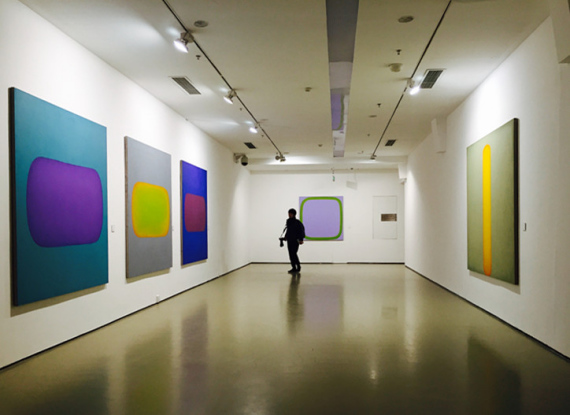
Organizers and artists participating in the Research Exhibition of Abstract Art in China meet the press on January 24.(From L: Gao Peng,Director of Today Art Museum;Li Xu,Deputy Director, Power Station of Art (Shanghai); Wang Duanting, researcher with CNAA; Tan Ping, Vice President of CNAA; Zhu Qingsheng, director of Peking University's Research Center of Visual and Graphic; Huang Du,noted curator)(Photo: Ecns.cn/Feng Shuang)
(ECNS) -- Beijing's winter is in full swing. Strong winds howled while sweeping through bare trees. Inside the No. 1 building of Today Art Museum, the rigid lines of structure and plain white walls all echoed with the external cold.
However, the simple venue, with almost zero decoration except for some spotlights, offers a great space for the display of abstract art collections. These include the Research Exhibition of Abstract Art in China, which kicked off on the coldest weekend in the city's history.
Without disturbance from the environment, the art works strike out in a more powerful way in this neat and clean space. Dots, lines, shapes and colors are weaved into a feast for the eyes, communicating the artists' emotion in a compelling visual language.

As an alternative to figurative art, abstract works always go beyond depicting the reality to explore the inner world of the artists and their relationship with the environment – an art form "demands quite a logical way of thinking", in the words of Wang Duanting, a researcher with the Chinese National Academy of Arts, which organized the event with Today Art Museum.
Abstract art is quite new to Chinese people. It was only introduced to the country after opening-up in late 1970s, according to the preface of the exhibition. In what the curators called a "serious exhibition", the retrospective show, for the first time, looks back at Chinese artists' achievements in this important domain of modern art over the past three decades.
"The growth of abstract art in China goes along with development of the country. It's interesting to explore how this art culture is adapted into the Chinese context," said Huang Du, a member of the curating committee.
"Chinese characters are not limited to the use of symbolic cultural elements," Wang Daunting added, saying that "What we really want to demonstrate is the spirit of Chinese philosophy carried out by abstract art forms."


















































